The current economy is driving financial decisions and it is more important than ever for companies to ensure they receive the most benefit for dollars allocated to technology implementation or upgrades. Although most top vendors have complete product offerings and their models have improved to account for multiple skill sets, locations, time zones, and channels, they cannot all offer the same quality. Workforce management (WFM) systems should be designed to save money and increase efficiency in your call center. Marketing hype does not ensure that what you are sold is what you are getting. Before investing in WFM technology, consider maximizing your investment dollars with features that can increase performance and efficiency while addressing long term needs.
For almost thirty years Pipkins has been at the forefront of WFM technology with thirteen industry-first applications. Pipkins’ solutions are typically three to five years ahead of the curve for innovation, application, and ease of use.
This paper discusses five powerful differentiators that establish Pipkins’ competitive advantage and helps companies make better purchasing decisions when shopping for WFM technology.
Five Features Unique to Pipkins
1. One database
Perhaps one of the most important differentiators … Pipkins is the only vendor that provides a single server database and architecture platform for workforce and performance management solutions for both the front and back office.
The flexibility of our premise or hosted WFM technology will fit the needs of any IT department. Our unique capability to manage every contact channel, and deliver them into a single server, provides real time visibility organizations need to make critical decisions.

2. Advanced Forecasting Capability
Companies and industry insiders that have evaluated our capabilities view Pipkins as the technology and quality leader in call center forecasting and scheduling resource management systems. Pipkins’ Merlang® improves upon traditional Erlang-C algorithms by eliminating the assumptions that queues are infinitely long, callers never abandon the queue, and all calls have to be answered by one group of agents.
Advanced forecasting with Merlang™ algorithms – Merlang®-M is an advanced forecasting algorithm that directly calculates requirements in a multi-skilled environment, avoiding repetitive analytical simulations. Merlang® equations offer several advanced features that are not available from WFM technology packages that use Erlang-C, including the prediction of the number of abandons and busies, and the optimal distribution of agents within skill groups.
Not only are the results far more accurate than what is produced from Erlang-C, you get the right answers the first time without having to resort to costly trial-and-error simulation methods.
Sum of Squares – least sum of squares algorithm – Pipkins’ advanced schedule optimization is based on a Sum of Squares figure of merit analysis, not a simple “hours-net-to-zero.” Competing algorithms that use the net-to-zero approach cannot distinguish between schedules that deliver good and bad service. Only Pipkins’ algorithms can truly optimize.
The Scheduler included in Pipkins’ WFM technology uses this algorithm to maximize the achievable quality of service. The algorithm takes the difference between required and provided staff for each schedule time step interval during the period to be scheduled, then squares and sums each figure to determine the sum of squared differences. The Scheduler works to minimize this figure for a time step, for the total day, and for the entire date range being scheduled. For example:
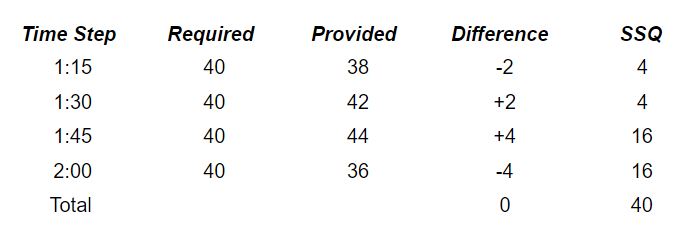
By adjusting start/stop times and lunch/break times, the scheduler lowers the SSQ until the schedule is optimized for each time step.
This method of assessing a schedule’s accuracy offers two advantages:
- Because the differences are squared before summed, staffing excesses and deficiencies do not cancel each other as they would if they were simply added.
- The relationship between staff numbers and quality of service is non-linear, and is best represented by the squaring function. For example, as 2 squared is 4, the Scheduler regards a staffing deficiency of 2 as being 4 times as bad as a deficiency of 1. This is a fair reflection of the expected reduction in service.
3. Policies and Advanced Directives
A dynamic solution for handling customized organizational rules and policies, the Advanced Directive commands in Pipkins’ WFM technology allow you to include custom scripts or policies when generating a forecast or schedule that ensures your company’s unique, customized needs are included. Policies use Advanced Directive commands in addition to the forecast algorithm and schedule rules so your company’s forecast and scheduling requirements are included in the adjusted forecast and schedule.
Policies and Advanced Directives enable you to define and configure organizational Policies that can be easily included when generating forecasts, schedules, rosters and exception requests. Policies and Directives negate the need for lengthy “workarounds” by addressing special needs specific to your company as they occur.
The benefits of Policies and Advanced Directives are numerous. Adapting companies’ unique business rules alleviates back-end processes (workarounds) and saves manual time. One of the biggest benefits of Policies and Advanced Directives is speed of delivery (typically, one week to one month) as opposed to workarounds that can take up to one-three years, or never. Policies and Advanced Directives handle business critical enhancements quickly and changes can be made easily and accommodate an unlimited amount of policies. Policies and Advanced Directives also address the complex exception prioritizations that occur during peak seasons. Balancing time-off planning while meeting client service levels give analysts a myriad of options and scenarios based on priority. Weekly exceptions and possible conflicts are easily addressed based on ranking of importance over partial or full day. For example, selecting a department-organized policy that would take a non-work event, such as the vacation exception, over the planned work exception of the all day training session, can be accomplished without manual manipulation of a schedule, or
having to clear, remove and re-run schedules.
The options are infinite with Policies and Advanced Directives. They are especially effective for:
- short or long-term forecasting
- intraday forecasting
- enhanced special event and holiday planning
- unique scheduling rules
- staffing requirements
- multi-skilled with aggregate queue sensitivity
- vacation planning rules
- ability to prioritize exceptions
- re-optimization policies
- individual staff availability
- preferences
- schedule trade and change request rules
- short term exception initiatives
- any rule specific to your organization
4. At-home agent suite
Based on the powerful Policies and Advanced Directives application that addresses organizational rules and policies, Pipkins is the only workforce management provider with agent self-scheduling capability in its WFM technology. @HomeVantage utilizes Pipkins’ powerful forecasting tools to ensure optimal scheduling.
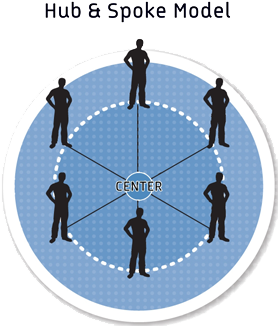 Many organizations prefer a “Hub and Spoke” model in which agents begin working in the call center, then after a period of time move to an at-home position within a certain mile radius of the center. This provides flexibility for the agent to come into the center during emergencies, company meetings, or for other activities.
Many organizations prefer a “Hub and Spoke” model in which agents begin working in the call center, then after a period of time move to an at-home position within a certain mile radius of the center. This provides flexibility for the agent to come into the center during emergencies, company meetings, or for other activities.
Pipkins’ @HomeVantage is easily adaptable to the Hub and Spoke model. Vantage Point schedules both call center and at-home agents. Agents can be part of the “hub” schedule generation process, or build their own schedules by requirements generated by the workforce team. This ensures optimal scheduling to allow at-home agents flexibility to fill staffing gaps.
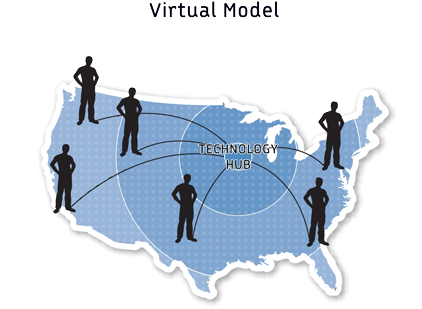
As contact centers become truly virtual with at-home agent models, it is desirable to fully utilize the benefits of the scheduling tool in your WFM technology. Pipkins’ @HomeVantage allows virtual agents to pick and choose blocks of time in which they can build their own shifts according to established company rules and staffing requirements. The Virtual Model provides optimal utilization of remote agents to fill staffing requirements based on business needs, while improving agent morale and autonomy through use of self service tools.
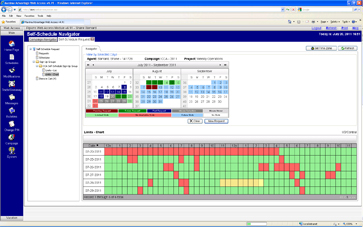 Pipkins’ @HomeVantage provides an easy agent self-service scheduling tool. Agents use a checkout method for self-scheduling to accommodate staffing requirements based on business needs. The scheduling process ensures rules specific to organizational needs are met, including break and lunch times, hours worked, and any other specific needs.
Pipkins’ @HomeVantage provides an easy agent self-service scheduling tool. Agents use a checkout method for self-scheduling to accommodate staffing requirements based on business needs. The scheduling process ensures rules specific to organizational needs are met, including break and lunch times, hours worked, and any other specific needs.
Pipkins’ @HomeVantage gives organizations the ability to effectively manage their agents as the At-Home Agent Model phenomenon continues to rapidly grow. Pipkins’ @HomeVantage can be used with Vantage Point, or integrated into another workforce management system to leverage existing WFM technology you may have in place.
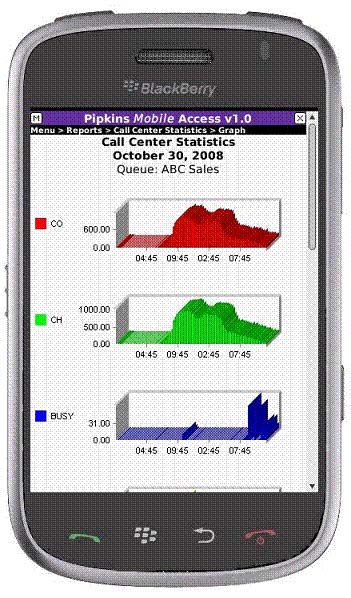 5. Smart phone interface
5. Smart phone interface
Smartphone support is offered exclusively for Pipkins’ Vantage Point Web Access module. This enhancement to the firm’s WFM technology enables users equipped with Smartphones to check agent status at a glance, modify schedules with a click while in meetings or off-site, send messages and notifications, and view reports from hundreds of miles away.
Supervisors can log changes such as sick days or early releases, view agent schedules, and send popup and email messages with a click from the same grid without navigating to different screens. Reports such as staffing effect summaries, adherence summaries for individual agents or the entire staff, and scheduled and actual activity summary graphs are available from the same control screen.
Features:
Leverages Smartphone’s display and touch controls to deliver remote browser-based access to the full functionality of the Web Access module, including both the graphic interface and one-click update capabilities.
Displays graphical layout in the proper horizontal orientation as well as color-coding for identifying out-of-compliance agents.
Drills down to the fine details in highly readable text, and allow supervisors to access information or make schedule changes simply by touching a finger to the screen.
One-click report access enabling supervisors to retrieve staffing effect summaries, adherence summaries for individual agents or the entire staff, scheduled and actual activity summary graphs, and other reports from the adherence screen. Reports can be configured to dock or pop up.
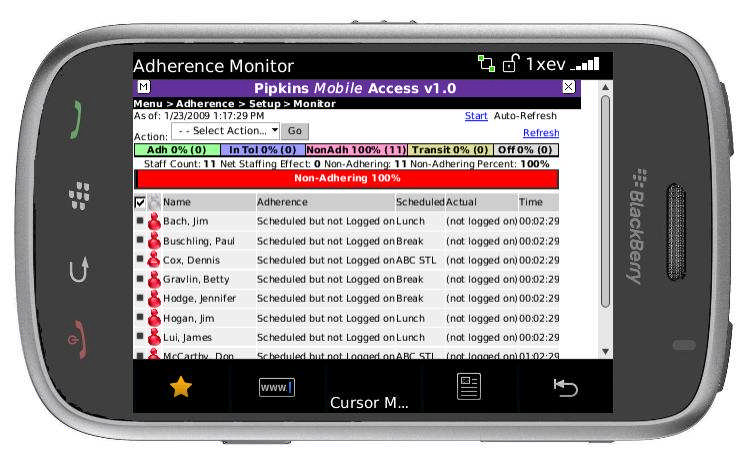 Dynamic color changes for the entire square or agent icon, showing whether the agent is in adherence, not in adherence, not in adherence but within tolerance, schedule to arrive within two hours, arriving or leaving within 30 minutes, or off. The size of the squares and icons makes the
Dynamic color changes for the entire square or agent icon, showing whether the agent is in adherence, not in adherence, not in adherence but within tolerance, schedule to arrive within two hours, arriving or leaving within 30 minutes, or off. The size of the squares and icons makes the
colors easy to see, even at a distance.
One-click schedule updates from the adherence control panel, eliminating the need to navigate to separate screens to log schedule changes such as late arrivals, sick days or early releases. Users simply click “Schedule” in the non-adhering agent’s square to access a menu of update options. Users can also view agent schedules and send popup and email messages with a click
from the same menu.
Pipkins will deliver what is promised. Don’t leave money on the table by making the wrong purchasing decision. To ensure you are getting the best system for your needs and avoid making a costly mistake, ask these questions before purchasing WFM technology.
Does the system collect enough data to produce accurate forecasts?
Look for a workforce management package that will maintain several years’ worth of very detailed data for maximum forecast accuracy.
Can the system recognize special events when forecasting call volumes?
In call centers where workloads fluctuate due to special events such as catalog drops or discount offers, the only way to ensure proper staffing is with a system that can electronically calculate anticipated call volume based on how a given event affected incoming calls in the past.
Does the system produce a single optimized schedule?
Look for a system that automatically incorporates breaks, lunches and so on when producing a schedule.
How long does it take to generate forecasts and schedules?
To determine the performance of the system you’re looking at, ask the vendor to perform a simulation based on a year’s worth of your own forecast data, and then time it.
Can you automate tasks that must be performed repeatedly?
You can do the work in half the time if recurring functions can be pre-configured with shortcut wizards for one-click execution, prescheduled to run automatically, or linked in self-executing sequences.
Can the system adjust for daily “surprises” like absences or unplanned meetings?
Find out if the WFM technology package you’re evaluating has intraday optimization tools that can recalculate the day’s staffing needs; modify breaks, lunches and work assignments electronically; and automatically alert agents by email and/or pop-up message to eliminate the need to print and distribute new schedules.
Is there an integrated vacation planner, and can it adapt to your needs?
The vacation planning module should integrate with the workforce management software to ensure that vacation slots will be calculated accurately and reflected in agents’ schedules without manual input, etc. It should also be fully configurable to support your policies and staffing structure.
Are busies and abandoned calls considered in calculating requirements?
Systems that don’t understand busies and abandons will always overstaff your call center. Ask whether the software you’re considering has an algorithm that incorporates busies and abandoned calls in its calculations.
Is the system scalable?
Many workforce management systems require call centers to perform a forklift upgrade once they grow to a certain size. Scalable WFM technology that can accommodate growth without installing completely new software is a much better way to go.
Conclusion
Pipkins is a boutique company specializing in workforce management. Focusing on one product allows us to offer unique solutions not found with any other workforce management vendor. We have flexibility to customize our solutions to fit your needs with unmatched speed of delivery and no long development cycles. The power of Pipkins’ software lies in our algorithms and accurate forecasting capability. We offer the most accurate forecasting/scheduling tools in the industry. Pipkins is the leader in workforce management and the worldwide answer to call center success.
